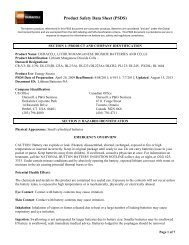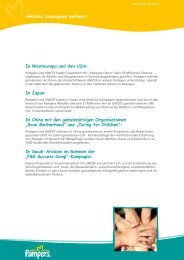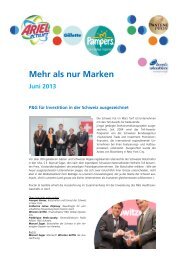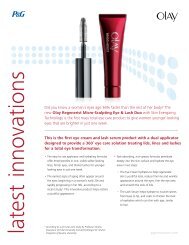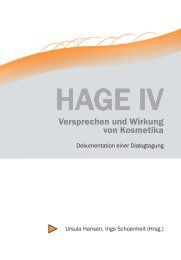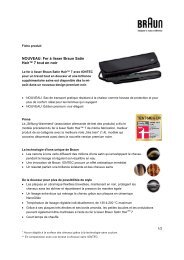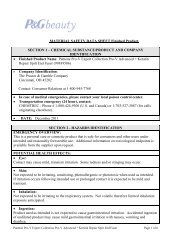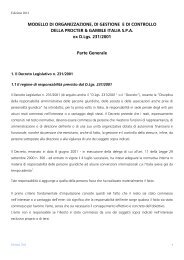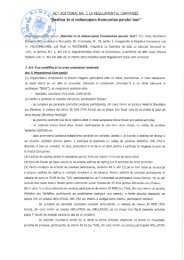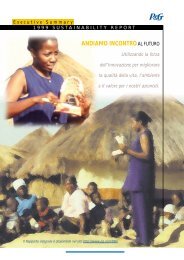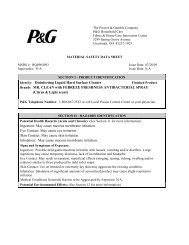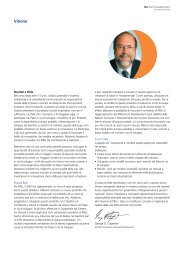P&G 2009 Annual Report – AnnualReports.com - Procter & Gamble
P&G 2009 Annual Report – AnnualReports.com - Procter & Gamble
P&G 2009 Annual Report – AnnualReports.com - Procter & Gamble
You also want an ePaper? Increase the reach of your titles
YUMPU automatically turns print PDFs into web optimized ePapers that Google loves.
66 The <strong>Procter</strong> & <strong>Gamble</strong> Company Notes to Consolidated Financial Statements<br />
Plan Assets. Our target asset allocation for the year ended June 30,<br />
<strong>2009</strong>, and actual asset allocation by asset category as of June 30, <strong>2009</strong><br />
and 2008, were as follows:<br />
Asset Category<br />
Amounts in millions of dollars except per share amounts or as otherwise specified.<br />
Target Asset Allocation<br />
Pension<br />
Benefits<br />
Other<br />
Retiree<br />
Benefits<br />
Equity securities (1) 45% 93%<br />
Debt securities 55% 7%<br />
TOTAL 100% 100%<br />
Asset Allocation at June 30<br />
Pension Benefits Other Retiree Benefits<br />
Asset Category <strong>2009</strong> 2008 <strong>2009</strong> 2008<br />
Equity securities (1) 42% 45% 93% 96%<br />
Debt securities 51% 50% 7% 4%<br />
Cash 6% 3% — —<br />
Real estate 1% 2% — —<br />
TOTAL 100% 100% 100% 100%<br />
(1) Equity securities for other retiree plan assets include Company stock, net of Series B ESOP<br />
debt, of $2,084 and $2,809 as of June 30, <strong>2009</strong> and 2008, respectively.<br />
Our investment objective for defined benefit retirement plan assets is<br />
to meet the plans’ benefit obligations, while minimizing the potential<br />
for future required Company plan contributions. The investment<br />
strategies focus on asset class diversification, liquidity to meet benefit<br />
payments and an appropriate balance of long-term investment return<br />
and risk. Target ranges for asset allocations are determined by matching<br />
the actuarial projections of the plans’ future liabilities and benefit<br />
payments with expected long-term rates of return on the assets,<br />
taking into account investment return volatility and correlations across<br />
asset classes. Plan assets are diversified across several investment<br />
managers and are generally invested in liquid funds that are selected<br />
to track broad market equity and bond indices. Investment risk is<br />
carefully controlled with plan assets rebalanced to target allocations<br />
on a periodic basis and continual monitoring of investment managers’<br />
performance relative to the investment guidelines established with<br />
each investment manager.<br />
Cash Flows. Management’s best estimate of cash requirements for<br />
the defined benefit retirement plans and other retiree benefit plans<br />
for the year ending June 30, 2010, is approximately $616 and $24,<br />
respectively. For the defined benefit retirement plans, this is <strong>com</strong>prised<br />
of $178 in expected benefit payments from the Company directly to<br />
participants of unfunded plans and $438 of expected contributions<br />
to funded plans. For other retiree benefit plans, this is <strong>com</strong>prised of<br />
expected contributions that will be used directly for benefit payments.<br />
Expected contributions are dependent on many variables, including<br />
the variability of the market value of the plan assets as <strong>com</strong>pared<br />
to the benefit obligation and other market or regulatory conditions.<br />
In addition, we take into consideration our business investment<br />
opportunities and resulting cash requirements. Accordingly, actual<br />
funding may differ significantly from current estimates.<br />
Total benefit payments expected to be paid to participants, which<br />
include payments funded from the Company’s assets, as discussed<br />
above, as well as payments from the plans, are as follows:<br />
Years ending June 30<br />
EXPECTED BENEFIT PAYMENTS<br />
Pension<br />
Benefits<br />
Other Retiree<br />
Benefits<br />
2010 $ 499 $ 184<br />
2011 496 201<br />
2012 507 217<br />
2013 525 232<br />
2014 552 247<br />
2015–2019 3,096 1,453<br />
Employee Stock Ownership Plan<br />
We maintain the ESOP to provide funding for certain employee<br />
benefits discussed in the preceding paragraphs.<br />
The ESOP borrowed $1.0 billion in 1989 and the proceeds were used<br />
to purchase Series A ESOP Convertible Class A Preferred Stock to fund<br />
a portion of the U.S. DC plan. Principal and interest requirements of<br />
the borrowing were paid by the Trust from dividends on the preferred<br />
shares and from advances provided by the Company. The original<br />
borrowing of $1.0 billion has been repaid in full, and advances from<br />
the Company of $178 remain outstanding at June 30, <strong>2009</strong>. Each<br />
share is convertible at the option of the holder into one share of the<br />
Company’s <strong>com</strong>mon stock. The dividend for the current year was equal<br />
to the <strong>com</strong>mon stock dividend of $1.64 per share. The liquidation<br />
value is $6.82 per share.<br />
In 1991, the ESOP borrowed an additional $1.0 billion. The proceeds<br />
were used to purchase Series B ESOP Convertible Class A Preferred<br />
Stock to fund a portion of retiree health care benefits. These shares,<br />
net of the ESOP’s debt, are considered plan assets of the Other Retiree<br />
Benefits plan discussed above. Debt service requirements are funded by<br />
preferred stock dividends, cash contributions and advances provided<br />
by the Company, of which $266 is outstanding at June 30, <strong>2009</strong>.<br />
Each share is convertible at the option of the holder into one share<br />
of the Company’s <strong>com</strong>mon stock. The dividend for the current year<br />
was equal to the <strong>com</strong>mon stock dividend of $1.64 per share. The<br />
liquidation value is $12.96 per share.<br />
Our ESOP accounting practices are consistent with current ESOP<br />
accounting guidance, including the permissible continuation of certain<br />
provisions from prior accounting guidance. ESOP debt, which is<br />
guaranteed by the Company, is recorded as debt (see Note 4) with an<br />
offset to the Reserve for ESOP Debt Retirement, which is presented<br />
within Shareholders’ Equity. Advances to the ESOP by the Company<br />
are recorded as an increase in the Reserve for ESOP Debt Retirement.<br />
Interest incurred on the ESOP debt is recorded as interest expense.<br />
Dividends on all preferred shares, net of related tax benefits, are<br />
charged to retained earnings.



